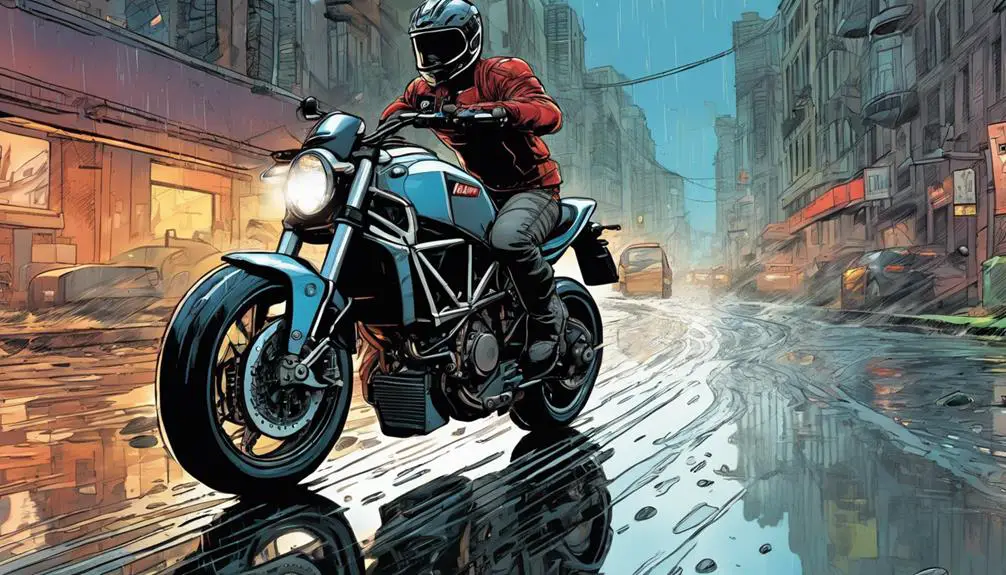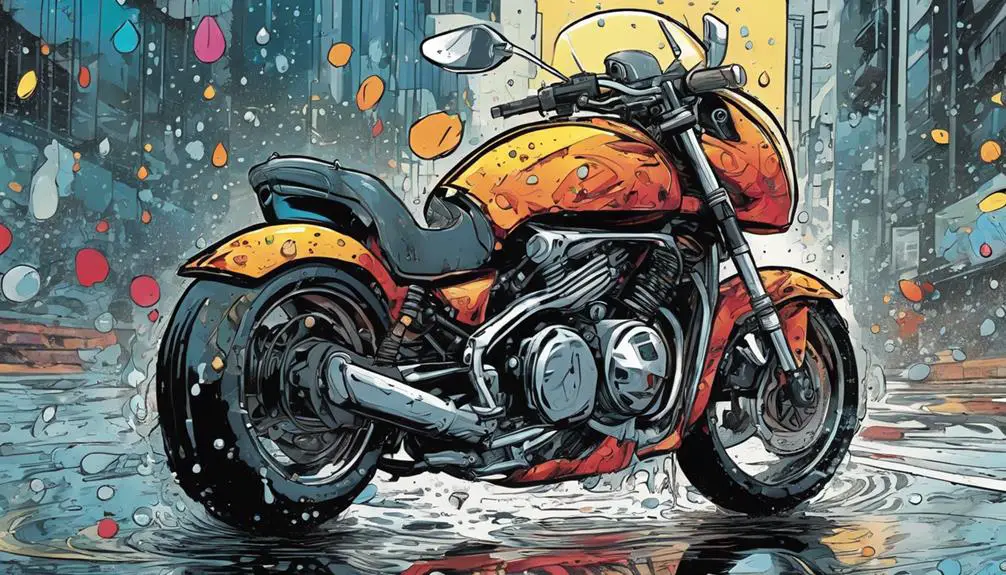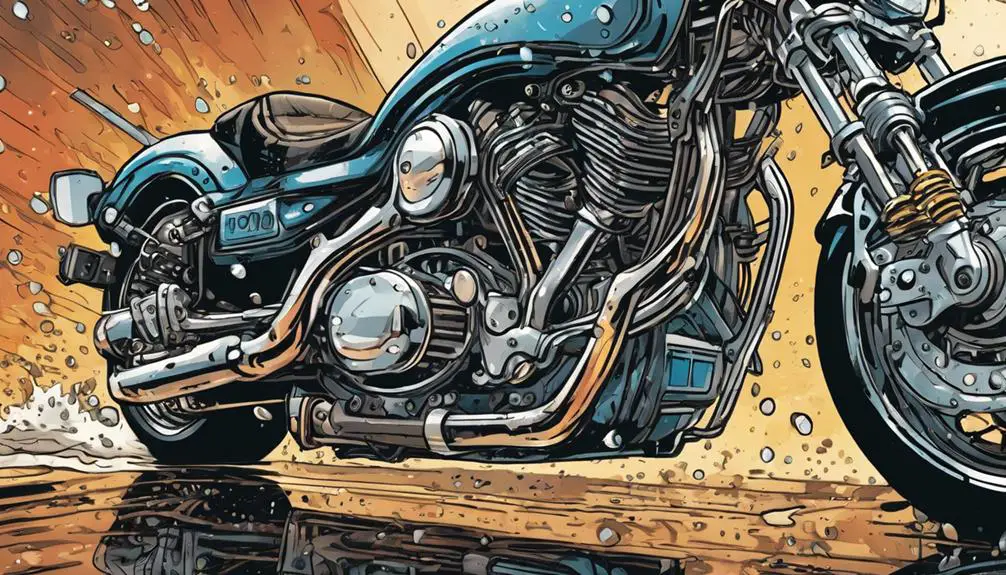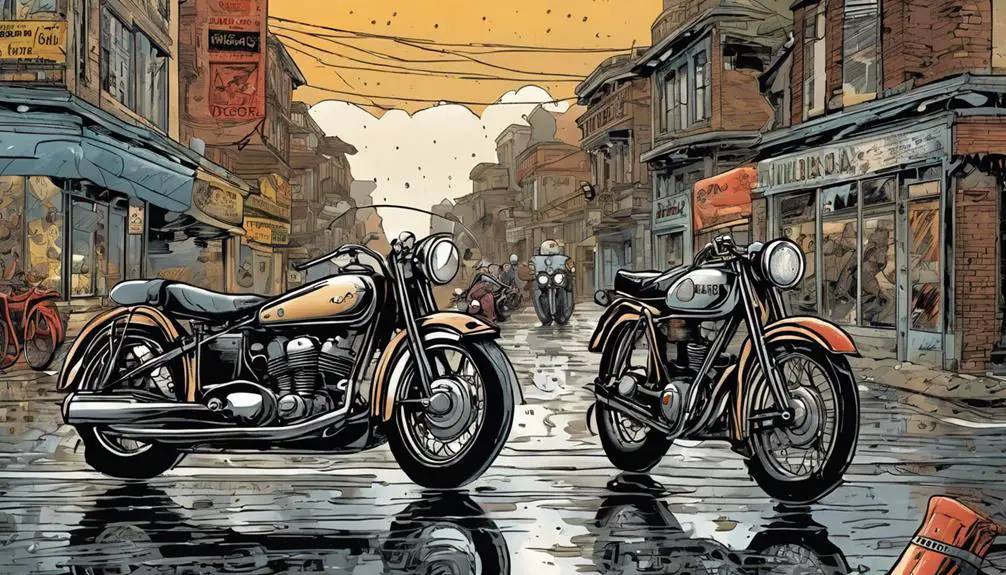Take Ducati's Multistrada, for instance; it's designed with advanced traction control that adapts seamlessly to wet conditions. You might wonder how certain motorcycles manage to maintain grip and stability when the roads turn slick. The answer lies in a combination of specialized features that enhance performance while keeping safety at the forefront. As you explore the mechanics behind these impressive wet-weather capabilities, you'll uncover why some riders feel more confident maneuvering through rain than others.
Key Takeaways
- Advanced traction control systems automatically adjust power delivery, enhancing grip and stability on wet surfaces for safer riding experiences.
- Rain mode functionality smooths throttle response, allowing for gradual acceleration and minimizing the risk of slips in slick conditions.
- Specialized tire technology features deep grooves and softer compounds, significantly improving grip and reducing hydroplaning on wet roads.
- Well-tuned suspension systems absorb irregularities and maintain balance, ensuring stability and control during maneuvers on slippery surfaces.
Ducati's Advanced Traction Control

Ducati's advanced traction control system helps you maintain grip and stability, especially when riding in wet weather. It's designed to sense changes in wheel spin and adjust power delivery accordingly, guaranteeing you stay in control no matter the conditions. When the road gets slick, you want a bike that responds intuitively, and Ducati delivers just that.
Imagine carving through corners, feeling the freedom of the open road, even as rain pelts down. This system works seamlessly in the background, allowing you to focus on the thrill of the ride rather than worrying about losing traction. It empowers you to embrace your passion for riding without hesitation.
The beauty of this technology lies in its adaptability. You're not just a passenger; you're an active participant in a dynamic experience. As you lean into turns or accelerate from a stop, the traction control system guarantees that you can express your riding style while maintaining safety.
With Ducati, you're not sacrificing excitement for security; you're enhancing it. So, gear up, embrace the elements, and let the road be your canvas. Riding in wet weather becomes a liberating adventure, not an intimidating challenge.
Rain Mode Functionality
When you switch to Rain Mode on your motorcycle, you'll notice enhanced traction control kicks in, helping you maintain grip on slick surfaces.
This setting also adjusts the throttle response, making it easier to manage your power output in wet conditions.
Understanding these features can greatly improve your riding experience when the weather turns stormy.
Enhanced Traction Control
Many modern motorcycles feature enhanced traction control systems that include a rain mode functionality, designed to optimize grip and stability in wet conditions. When you're riding in the rain, this system kicks in to help you maintain control, allowing you to focus on the thrill of the ride instead of worrying about slipping or losing traction.
The rain mode adjusts the motorcycle's traction control settings, allowing for smoother power delivery and minimizing wheel spin. This means you can embrace the freedom of the open road, even when the skies are gray. You'll notice that the bike feels more planted, giving you the confidence to tackle corners and navigate through puddles without hesitation.
Enhanced traction control doesn't just make riding safer; it empowers you to explore your limits. You can push the boundaries of your adventure while knowing your motorcycle has your back.
This blend of technology and liberation offers a unique riding experience, where you can embrace the elements without fear. So, when the rain begins to fall, remember that your motorcycle's traction control system is there to support your journey, ensuring you can ride with both excitement and assurance.
Adjusted Throttle Response
Riders often notice a significant change in throttle response when switching to rain mode, as the system calibrates for smoother acceleration in slippery conditions. This adaptation creates a more forgiving ride, allowing you to navigate wet roads with confidence. Instead of feeling the urge to grip the throttle tightly, you can enjoy a more relaxed yet responsive experience, freeing you from the anxiety of potential slips.
When you twist the throttle in rain mode, the bike responds in a way that's more linear. This means that sudden bursts of power are less likely, helping you maintain control even on slick surfaces. You'll appreciate how this adjustment allows for gradual acceleration, giving you the freedom to explore without fear.
Additionally, the adjusted throttle response complements the enhanced traction control systems, creating a harmonious relationship between power and grip. You'll feel liberated as your motorcycle becomes an extension of your will, responding seamlessly to your commands despite the weather.
With rain mode engaged, you can ride with confidence, embracing the adventure of wet-weather journeys without compromising your safety or enjoyment. This isn't just riding; it's liberation on two wheels.
Lightweight and Agile Design

When you're riding in wet conditions, a lightweight and agile motorcycle makes all the difference.
Its enhanced maneuverability helps you navigate tricky spots, while the reduced risk of hydroplaning keeps you safer on slick roads.
You'll also appreciate the responsive handling characteristics that let you react quickly to changing conditions.
Enhanced Maneuverability
Lightweight and agile designs in motorcycles allow you to maneuver confidently through wet weather conditions. When the roads are slick, your bike's reduced weight means you can shift direction with ease, responding to the challenges that rain brings. You'll feel an invigorating connection to the road, enabling you to weave through obstacles and navigate tight corners without fear.
This kind of maneuverability isn't just about speed; it's about control. You can lean into turns, making those curves feel exhilarating rather than intimidating. With less bulk, your bike reacts quicker, allowing you to adapt as the road conditions change beneath you.
Imagine gliding through a downpour, the world around you transforming into a blur of colors and sensations. You're not just riding; you're dancing with the elements. The lightweight frame of your motorcycle empowers you, giving you the freedom to explore and embrace the adventure that wet weather can offer.
Reduced Hydroplaning Risk
How can a motorcycle's agile design help reduce the risk of hydroplaning in wet conditions?
When you're riding, a lightweight and nimble bike allows you to maintain better control over your movements. This agility helps you navigate through puddles and varying surfaces without losing grip. The reduced weight means less inertia, making it easier to adjust your position and balance as needed.
Additionally, the design of these motorcycles often includes narrower tires that slice through standing water, diminishing the chances of hydroplaning. With less surface area in contact with the water, you can cut through wet conditions more effectively, staying connected to the road beneath you.
You'll find that an agile motorcycle responds to your instincts, giving you the freedom to make quick adjustments. This responsiveness empowers you to ride confidently, even in the rain.
Responsive Handling Characteristics
The agile design of motorcycles not only reduces hydroplaning risk but also enhances responsive handling, making it easier for you to maneuver through challenging conditions.
When the roads turn slick, you want a bike that feels like an extension of yourself, effortlessly gliding through puddles and sharp turns. Lightweight frames and nimble components allow for quick adjustments, giving you the freedom to navigate tight spots without hesitation.
You'll feel the difference when you lean into a corner, as these machines respond instantly to your every input. The lower center of gravity keeps you grounded, ensuring stability even on slippery surfaces. As you twist the throttle, the bike's design encourages a sense of liberation, allowing you to embrace the rain rather than fear it.
Moreover, the agility of these motorcycles means you can dodge obstacles and react to sudden changes in the environment. You're not just riding; you're commanding your journey, even in less-than-ideal weather.
With responsive handling characteristics, you'll release your spirit of adventure, discovering that wet weather needn't limit your exploration. Instead, it can become an exhilarating part of your ride.
Tire Technology and Grip
When steering on wet roads, understanding tire technology and grip can make all the difference in your safety and control. Your tires aren't just rubber circles; they're your lifeline to the asphalt. Advanced compounds and tread designs enhance grip, channeling water away and minimizing hydroplaning risks. Look for tires that feature deep grooves and sipes, as these elements help to displace water effectively, keeping you connected to the road.
Investing in quality tires is essential for freedom on two wheels. The right tires offer not just traction but confidence, allowing you to tackle rainy rides without hesitation. You'll feel the difference in how your bike responds to your commands, especially when maneuvering turns or sudden stops.
Moreover, some manufacturers have developed specialized wet-weather tires, engineered to perform effectively in slippery conditions. These tires often feature softer compounds that stick better to wet surfaces, giving you a reassuring grip when it matters most.
Suspension Systems for Stability

A well-tuned suspension system enhances stability, allowing you to navigate wet roads with greater confidence and control. When rain slicks the pavement, your suspension plays a vital role in maintaining traction and balance. By absorbing bumps and irregularities, it keeps your tires firmly planted, reducing the risk of skidding or losing grip.
Imagine gliding through a downpour, your motorcycle responding effortlessly to your every command. A properly calibrated suspension system allows for smoother weight transfer, ensuring that you don't tip over during sudden turns or quick stops. You won't have to fear the unexpected; instead, you'll feel liberated, empowered to take on any challenge the weather throws your way.
Adjustable suspension setups are particularly beneficial, enabling you to fine-tune your ride for specific conditions. Whether you're tackling tight corners or straightening out on the highway, an adaptable suspension system keeps you grounded, even when the world around you is drenched.
Engine Performance in Rain
Rain can greatly impact engine performance, but with the right precautions, you can keep your bike running smoothly.
Water can seep into essential components, so make certain your air intake is protected. A well-maintained filter will keep moisture out, allowing your engine to breathe freely.
When you ride in wet conditions, throttle control becomes important. You'll want to avoid sudden acceleration, as this can lead to wheel spin and loss of traction. Instead, gradually increase your speed, giving your engine a chance to adapt to the slick surface.
Fuel delivery also plays a role. Consider using a fuel stabilizer to keep your engine's internals clean and functioning well. This can be especially beneficial if you park your bike outside, where exposure to rain may cause fuel issues.
Lastly, make sure your ignition system is in top shape. Wet weather can lead to misfires, so check that your spark plugs and wires are dry and intact.
Historical Performance in Wet Conditions

Motorcycles have evolved considerably in their ability to handle wet conditions, showcasing advancements in tire technology and braking systems that enhance rider safety and control. Historically, many riders faced challenges when tackling rainy roads. Early motorcycles relied on basic rubber tires that offered minimal grip, making it tough to maintain confidence while maneuvering slick surfaces.
As technology progressed, manufacturers began to prioritize wet-weather performance. You've likely noticed how modern tires are engineered with specific tread patterns designed to channel water away, reducing hydroplaning risks. This innovation gives you the freedom to ride with more assurance, even in downpours.
Braking systems have also seen significant improvements. The introduction of anti-lock braking systems (ABS) allows you to maintain control during sudden stops, preventing wheel lock-up on slippery roads. This means you can enjoy the thrill of riding without the constant fear of losing control.
In recent years, the focus on rider experience has only intensified, pushing manufacturers to create motorcycles that not only perform well in dry conditions but excel in the rain. This evolution reflects a commitment to your liberation on two wheels, regardless of the weather.
Common Issues and Solutions
Several common issues arise when riding in wet weather, but knowing how to address them can keep you safe and confident on the road.
One major concern is reduced traction. Wet surfaces can cause your tires to lose grip, so it's essential to slow down and avoid sudden maneuvers. Keep your body relaxed and maintain a steady throttle to enhance stability.
Hydration and visibility are also key. Rain can obscure your vision, so confirm your helmet visor is clean and consider using anti-fog solutions. Always check your lights and signals to guarantee you're visible to others.
Braking in wet conditions can be tricky too. Use both brakes gently to prevent skidding, and remember that it takes longer to stop on slick surfaces. If you encounter standing water, steer clear to avoid hydroplaning.
Frequently Asked Questions
What Brands Are Known for Excellent Wet Weather Performance?
When you're looking for motorcycles that excel in wet weather, a few brands stand out.
BMW, with its advanced traction control systems, gives you confidence on slick roads.
Honda's reliability and innovative designs also shine in rainy conditions.
You can't ignore Yamaha, known for its nimble handling.
Kawasaki's sport models offer excellent grip, too.
Each of these brands has engineered their bikes to keep you safe and in control, no matter the weather.
How Do Riding Techniques Differ in Wet Conditions?
When you're riding in wet conditions, you need to adjust your techniques for safety and control.
Lean into turns more gently, as sudden movements can cause skidding.
You should also increase your following distance; stopping takes longer on slick roads.
Use smoother throttle and brake inputs to maintain traction, and keep your eyes scanning ahead for potential hazards.
It's all about feeling the road and adapting to the elements around you.
Are There Accessories That Improve Wet Weather Riding?
Yes, there are several accessories that can greatly improve your wet weather riding experience.
Investing in high-quality waterproof gear, like jackets and pants, keeps you dry and comfortable.
Anti-slip grips for your handlebars enhance control, while rain covers for your seat prevent water buildup.
You might also consider installing a windscreen for better visibility.
These accessories not only protect you but also boost your confidence when maneuvering slippery conditions.
What Maintenance Tips Help Motorcycles Perform Better in Rain?
When it comes to maintaining your motorcycle for rainy conditions, don't stress about the extra effort—it's worth it!
Regularly check your tires for tread depth, guarantee your brakes are responsive, and keep your chain lubricated.
Cleaning your bike helps prevent rust, while a good waterproof cover protects it when parked.
Plus, investing in quality brake pads and wipers enhances your ride's safety.
A little maintenance goes a long way in keeping you confident on wet roads!
Do Weather Conditions Affect Motorcycle Insurance Premiums?
Yes, weather conditions can definitely affect your motorcycle insurance premiums. Insurers often consider risk factors like rain and snow, which can lead to more accidents. If you live in an area prone to severe weather, you might see higher rates.
However, if you take extra precautions, like investing in safety gear and maintaining your bike, you could potentially lower your premiums. Always shop around for the best rates that suit your riding style.
Conclusion
In the grand symphony of motorcycling, these machines don't just perform in the rain; they dance!
With their advanced traction control and agile designs, you'll feel like you're gliding on clouds, effortlessly conquering puddles and slippery turns.
Their innovative tire technology and well-tuned suspension become your secret allies, transforming dreary downpours into exhilarating adventures.
So, when the skies open up, embrace the thrill; you're not just riding – you're mastering the art of wet weather supremacy!